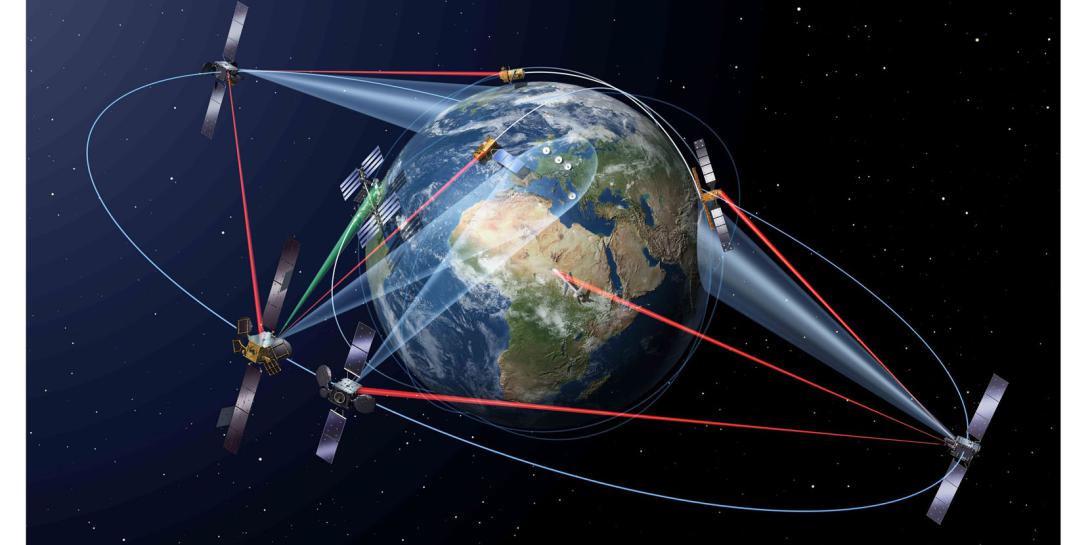Laser Communications Offer Promise
An alternative to radio frequency-based communications, laser communications, or optic-based technologies, are emerging as another tool for warfighters.
Stakeholders across the laser communications sector have formed an industry group, known as the Laser Communications Coalition. At the Institute of Electrical and Electronics Engineers (IEEE) and AFCEA International’s MILCOM conference in Los Angeles on October 30, some stakeholders shared their view of the technology and market outlook for their optic-based communications equipment or services.
Members from the coalition presenting their views of the laser communications (LASERCOM) industry included: Justin Luczyk, director, Business Development Space, Airbus Defense and Space Inc.; Arnie Streland, senior director, Strategy and Business Development, Northrop Grumman Innovation Systems; Barry Matsumori, CEO, BridgeSat Inc.; John Troeltzsch, senior manager, Commercial Aerospace and Strategic Technology Business, Ball Corp.; and Michael Abad-Santos, senior vice president, Americas, LeoSat Enterprises.
Airbus’ Luczyk explained that the company owns and operates Europe’s SpaceDataHighway, which was developed in a public-private partnership with the European Space Agency. The SpaceDataHighway can relay up to 40 terabytes of data to Earth, from either observation satellites, unmanned aerial vehicles (UAVs) or aircraft.
The highway uses laser communication terminals developed by Tesat-Spacecom and the DLR German Space Administration. The system’s first relay satellite, EDRS-A, was launched in 2016. The European Union’s Copernicus program uses the highway, and the company is looking to add more customers, Luczyk said.
According to the company, in 2019, the system will relay data and information from the Columbus module of the International Space Station (ISS) and in 2020, the Pleiades Neo satellites will begin to use the SpaceDataHighway.
Matsumori, of BridgeSat, emphasized that LASERCOM will be key in transmitting data, an important offering in the era of big data. LASERCOM offers customers small form factor laser communication terminals at a reduced price compared to equivalent radio frequency data throughput solutions. The company is engaging with the space industry’s LASERCOM terminal manufacturers to ensure compatibility with BridgeSat’s ground network. “BridgeSat is developing an optical communications network that offers secure delivery of big data from LEO satellites at faster speeds and at lower costs than traditional radio frequency.”
Streland, originally with Orbital ATK—which Northrop Grumman acquired in June in $9.2 billion transaction—addressed the potential applications for LASERCOM, for which Northrop Grumman Innovation Systems is working to build a customer base.
The company’s experience in LASERCOM extends from Orbital ATK’s success of the Near Field Infrared Experiment, or NFIRE satellite mission, which began 10 years as a Missile Defense Agency technology demonstration mission. The company demonstrated thousands of cross-links from Low Earth Orbit (LEO) to Geostationary (GEO), Streland said. “NFIRE helped advance the state-of-the-art ballistic missile detection system, accomplished bidirectional satellite laser communications at will and boosted international collaboration with Germany,” according to a company statement.
For Northrop Grumman, General Atomics is coming along as an important end user. There is a lot of interest, Streland said, given General Atomics’ stake in UAVs. Up until now, UAVs—which are now ubiquitous across the modern battlefield—have been operating in a benign radio frequency (RF) or communications environment, he stated.
Concern is growing as to how UAVs would survive in the future when threats increase. Streland said LASERCOM can offer a low-cost, secure alternative.
For the General Atomics MQ-9 Reaper, LASERCOM would enable the UAV to operate in a RF-contested environment. The Reapers are getting more and more capable sensors, and require large capacity downlinks to “get the data” home, Streland explained. He noted that General Atomics is investing its independent research and development (IRAD) dollars in building a modular laser terminal for the MQ-9 that will connect to Northrop Grumman’s relay satellite, enabling both RF or laser down to the ground. The companies are in the process of testing, with plans to experiment at Tenerife soon, he stated.
For Abad-Santos, LASERCOM offer impressive security. “The way that LeoSat looks at [LASERCOM’s] security, is that we no longer need a massive network of ground teleports, or ground infrastructure, because we have interconnected satellites,” he explained. “What that does for us is that lowers the threat factor. We can actually do true rooftop to rooftop communications, anywhere in the world, seamlessly, without touching any terrestrial ground.
Embassies, banks and even pharmaceutical companies, who all want to protecting their crucial intellectual property, are interested in being interconnected by laser communications, Abad-Santos stated.
Optic-based communications also offer flexibility, with preprogramed primary, secondary and tertiary routes, he said.
In addition, when joined with quantum keys, an emerging encryption technology, LASERCOM could prove to be a vitally secure platform, the experts agreed. Satellite-based quantum key distribution (QKD) uses a stream of polarized photons to create secret encryption keys, the most secure cryptography available.





Comments